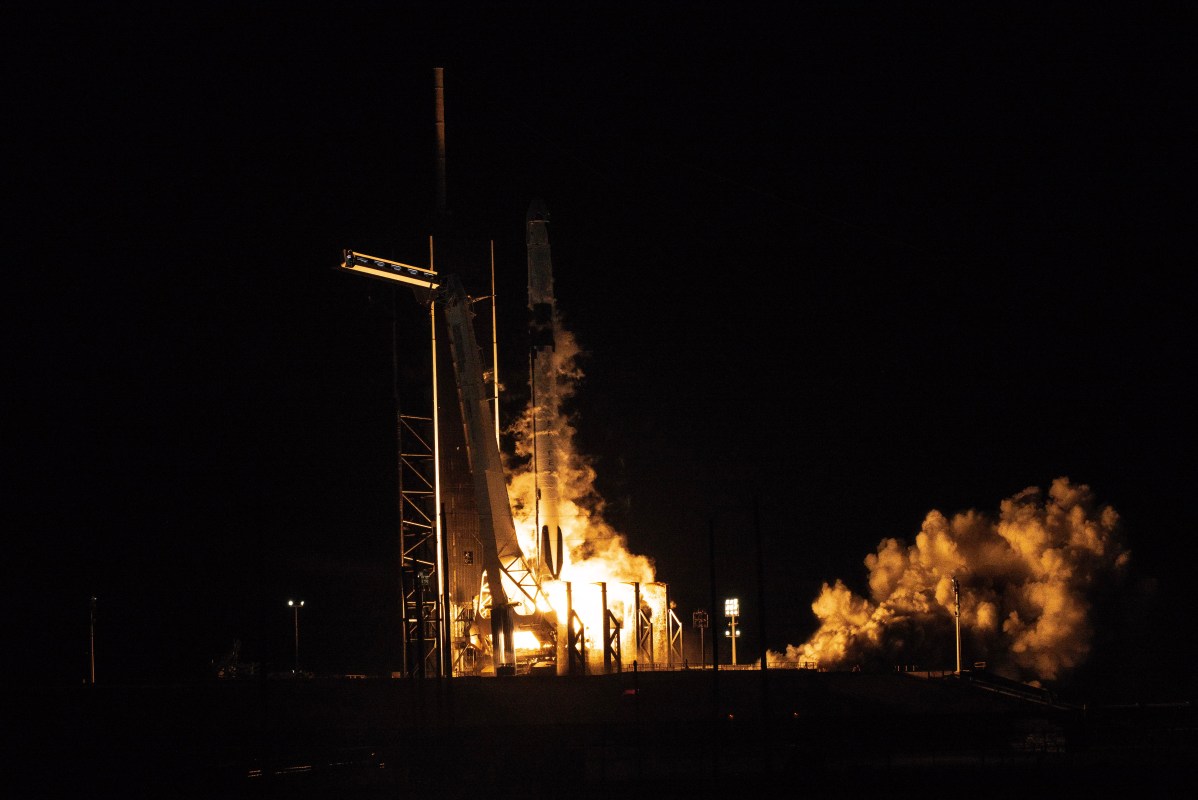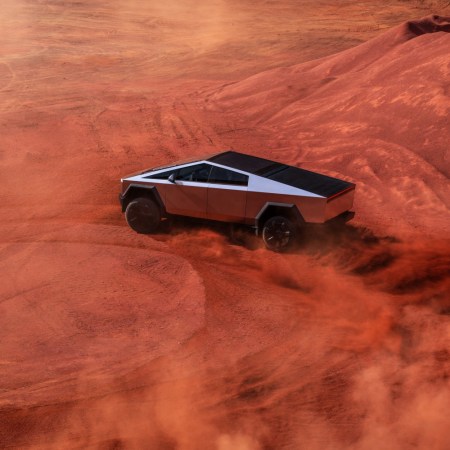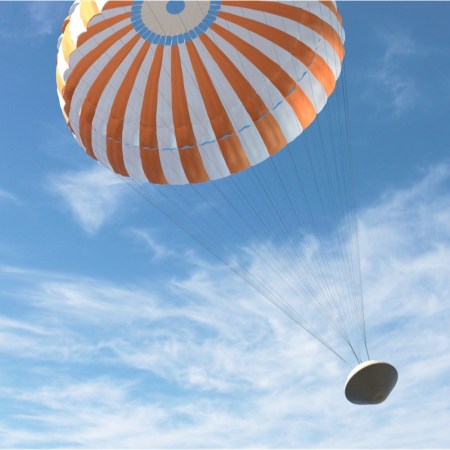At 2:40 a.m. on Saturday, March 2, people were still getting out of their cars in Titusville, Florida. Lugging lawn chairs, dragging drowsy children and powering up drones, hundreds of people gathered quietly on the Western shore of the Indian River to watch SpaceX’s Falcon 9 launch the company’s Crew Dragon capsule up and out of the atmosphere from the historic Pad 39-A just across the way on Merritt Island. Along the water, radios hummed with NASA’s broadcast of the launch, giving listeners a play-by-play as systems were checked and the green light was given for take-off.
Lightning cracked across the sky in the moments before the capsule began its maiden voyage to the International Space Station, illuminating otherwise invisible cumulus clouds. And then, at 2:49 a.m., the rocket rose into the air, carrying 400 pounds of cargo and a dummy astronaut nicknamed Ripley, after the hero of the Alien movie franchise. Light from the rocket’s exhaust flames ascended steadily, a small sun carving a blazing path through the darkness. Soon after came powerful sonic booms, louder than any Earthly thunder. The crowd craned their necks as the light became a streak, and then shrunk to a speck, blending in with the stars in a matter of minutes. Cheers and applause erupted from the riverbank, united in witnessing this small, but momentous, part of history.
The people watching already seemed to know what NASA administrator Jim Bridenstine and Kennedy Space Center director Robert Donald Cabana told press on a lawn just miles from Pad 39-A late on Friday afternoon:
A new era of space exploration has begun.
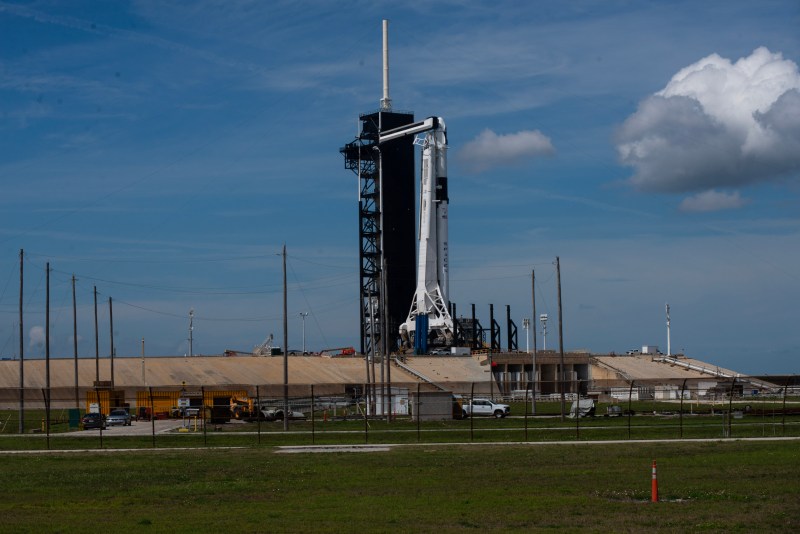
Saturday’s Demo-1 mission is unusual because it’s a foray into the unknown for SpaceX and for NASA, as well as the growing number of companies vying for a bite of the booming commercial space industry. What makes the Demo-1 mission different from those in years past, Bridenstine said, is that SpaceX is a private company, with Elon Musk at its helm, and NASA—a government agency funded by taxpayer dollars—is purchasing services from SpaceX. Bridenstine explained that this will be the new normal for the space agency.
“NASA is not going to purchase, own and operate the hardware. We’re going to be a customer,” Bridenstine said. “Our goal here is to be one customer of many customers driving down the cost and increasing the access to space in a very robust, commercial marketplace, for human spaceflight in low-Earth orbit.
“We also want ultimately to have numerous providers that are competing on cost and innovation…we’re going to have more access to space, at a better cost, than at any point in human history.”
It’s also momentous, Bridenstine and Cabana noted, because NASA is developing an entirely unique, new program. In response to a question about new procedures and preparations from RealClearLife, Cabana, who is a former astronaut, explained:
“One of the great things about this test flight is there are some differences. It’s not exactly the way we [NASA] did [the shuttle program], it’s not exactly the way we do cargo or launch service program missions…we’re setting up our procedures and processes to prepare us—this is a great learning event, all the way through—as we work through all the issues that we have to clear everything for readiness for this flight, and prepare the next step for actually putting crew on board.
“This isn’t just a test flight of the vehicle,” he added, gesturing to the Pad 39-A. “It’s a test flight of the entire leadership management team.”
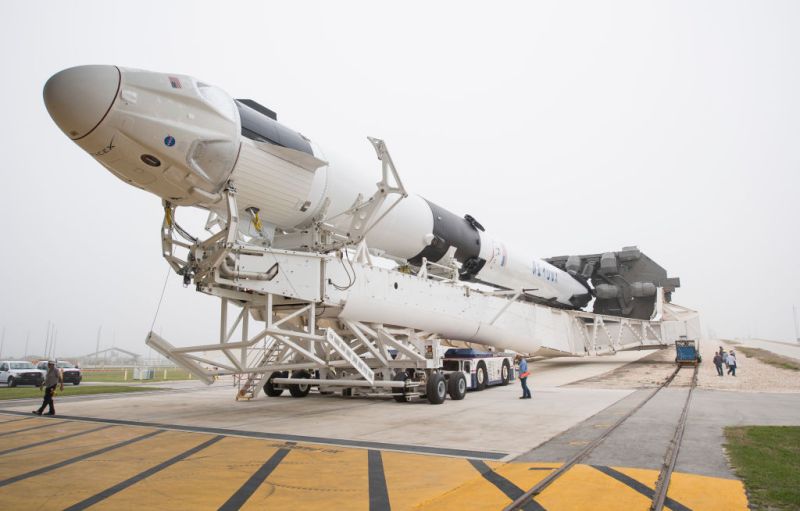
It’s not just a new, revitalized space program NASA is celebrating—it’s also something of a restart for its longtime home on Cape Canaveral.
“It is absolutely true that with the retirement of the space shuttles and the cancellation of Constellation, [Kennedy Space Center] was devastated,” Bridenstine said. “Because of the activities going on here under Bob (Cabana’s) leadership and previous NASA administrators, this center, the Kennedy Space Center, is thriving—and in fact, it’s growing,” he said. “We have a lot under development right now. In fact, you could argue we have more under development right now than at any time even during the Apollo era.”
With that development comes a ton of overtime. While the early-morning crowd of onlookers dissipated quickly after the launch, the work for those involved in the joint NASA-SpaceX Demo-1 mission was just beginning. NASA has outlined several objectives for Crew Dragon to complete, to ensure that its astronauts will be safe when they climb aboard the capsule themselves for the Demo-2 flight. The astronauts are currently training for that launch, tentatively scheduled for July 2019, which will be the first time since the space shuttle program shuttered in 2011 that American astronauts will head to space from U.S. soil. A vital part of that preparation, astronaut Doug Hurley said, is involving family as much as possible.
“I don’t know if you know this, but both Bob (Behnken) and I are married to astronauts, so in a lot of cases it makes the discussions at home a little easier,” Hurley, who is training for the Demo 2 flight, said. “I’ve told Victor (Glover) this a couple times—the hardest job is not your job, it’s the spouse that’s watching you launch into space. So an appreciation for that—whatever you can do to include your family in any event.”
Behnken echoed Hurley’s sentiments, explaining how he and his wife are preparing their child.
“The last time I flew into space, I didn’t have a son, now I have a four-year-old. He had not been to a rocket launch before, and I didn’t want his first one to be his father launching into space,” Behnken said. “And so we came down here and were on the top of the building just across the way, and watched [a cargo mission] together as a family in preparation for my eventual flight on a Falcon.”
The gravity of the commitment made by these astronauts is not lost on visitors of Titusville’s Space View Park. Just a few hundred yards away from the water’s edge where the crowd gathered to watch the launch stands monuments that honor the ultimate sacrifice: Engineers, electricians, lab assistants, heavy equipment operators, roofers, painters, and of course, astronauts, are all recognized for giving their lives in the ongoing pursuit of this final, wondrous frontier. In the hours after the launch, at the base of these monuments, anonymous passersby had laid fresh cut red roses. Bridenstine told reporters that it’s his “requirement” to make sure that, first and foremost, the crew of Demo-2 is safe.
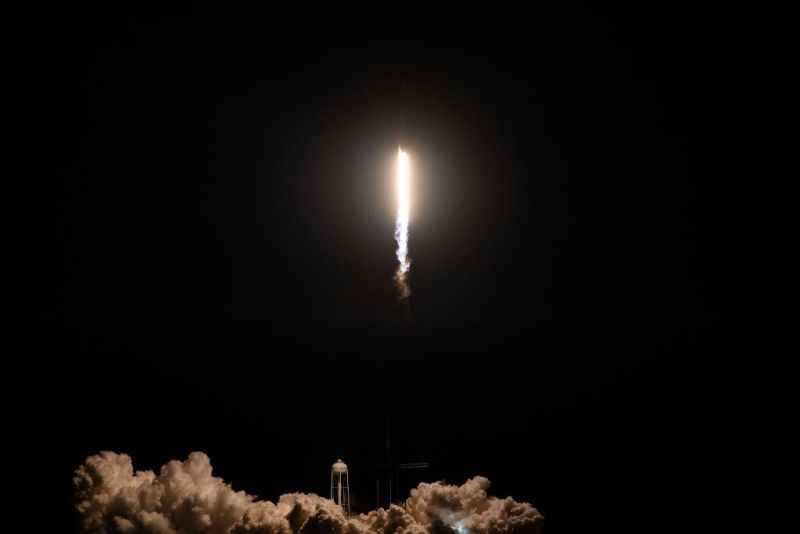
“I want to be clear about this point,” he said. “We are not in a space race. We have no requirement to go early…that race is over. We went to the moon and we won. It’s done. Now we’re in a position where we can take our time and get it right. That’s the goal here. Make sure we get it right. And that’s what we intend to do.”
On early Sunday morning, March 3, the Crew Dragon capsule successfully docked with the International Space Station. Watch the final leg of the Demo-1 mission’s journey below.
This article was featured in the InsideHook newsletter. Sign up now.
